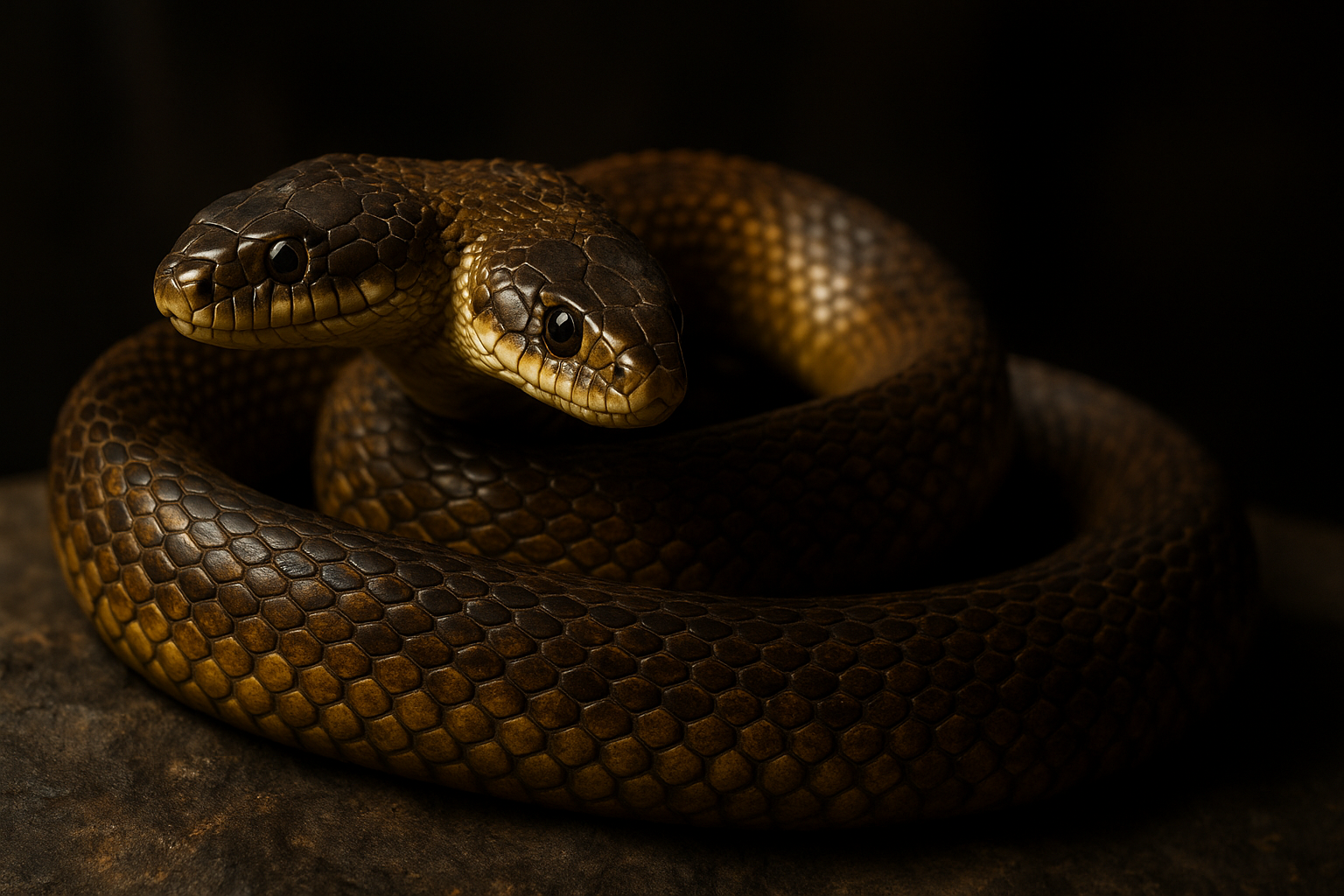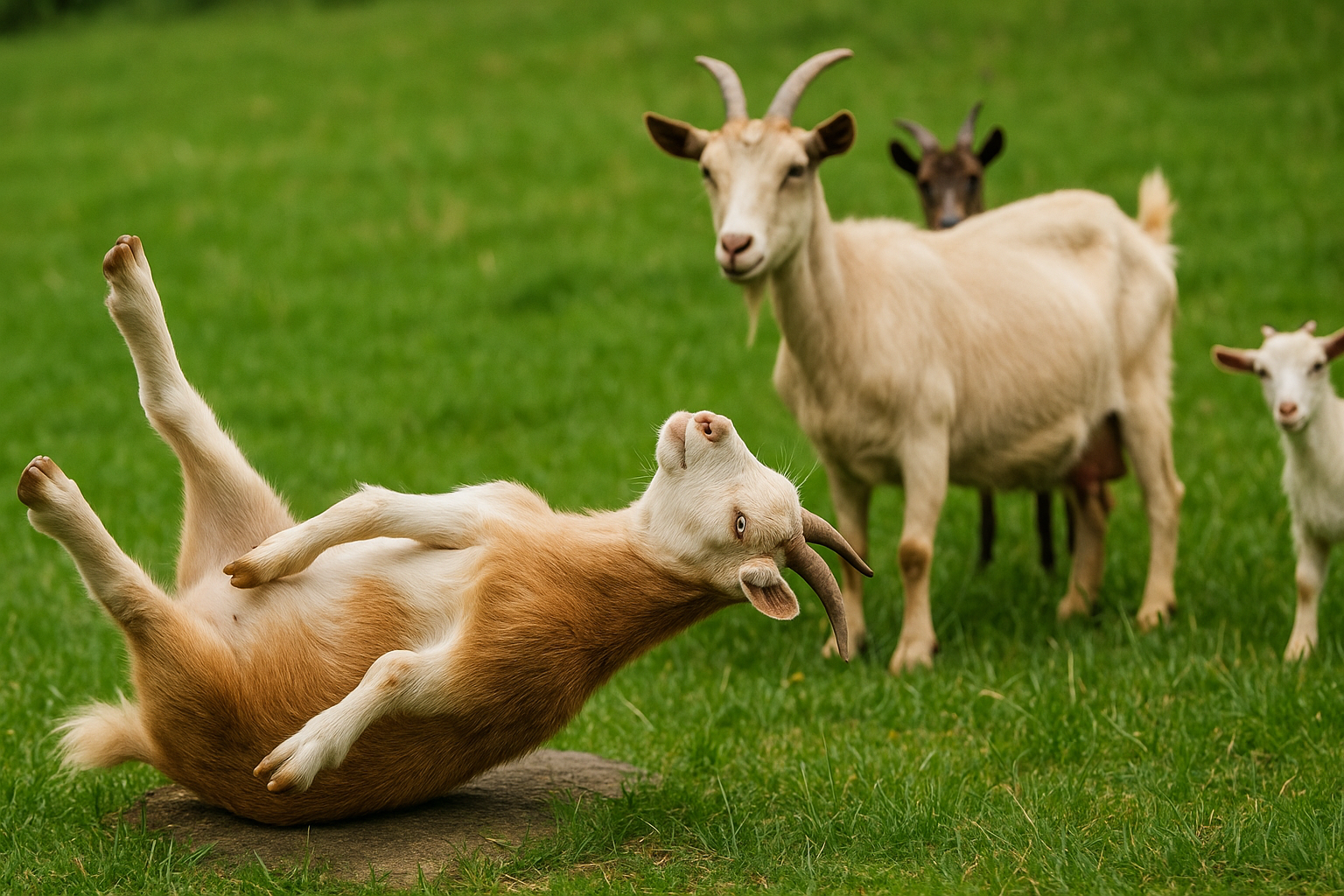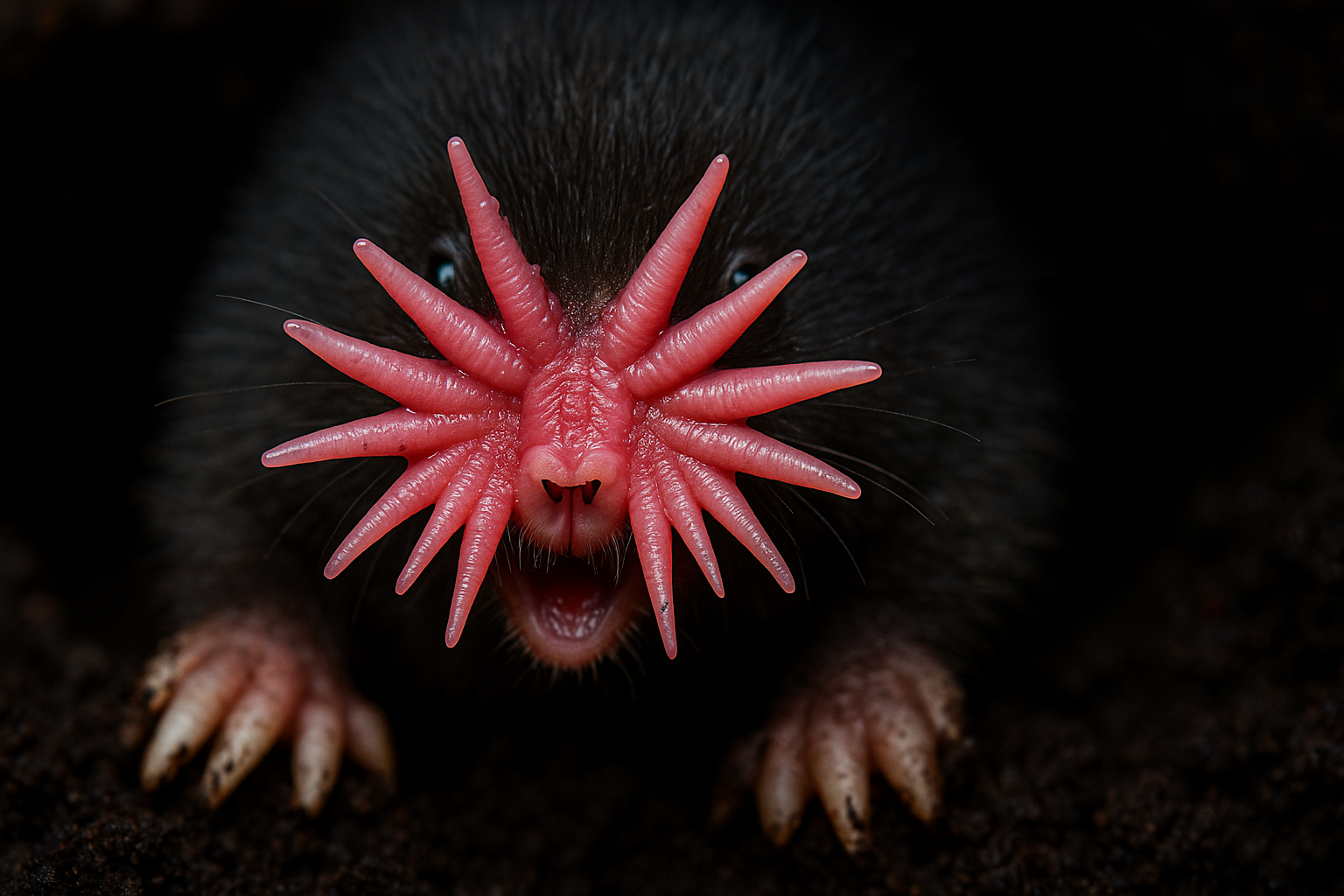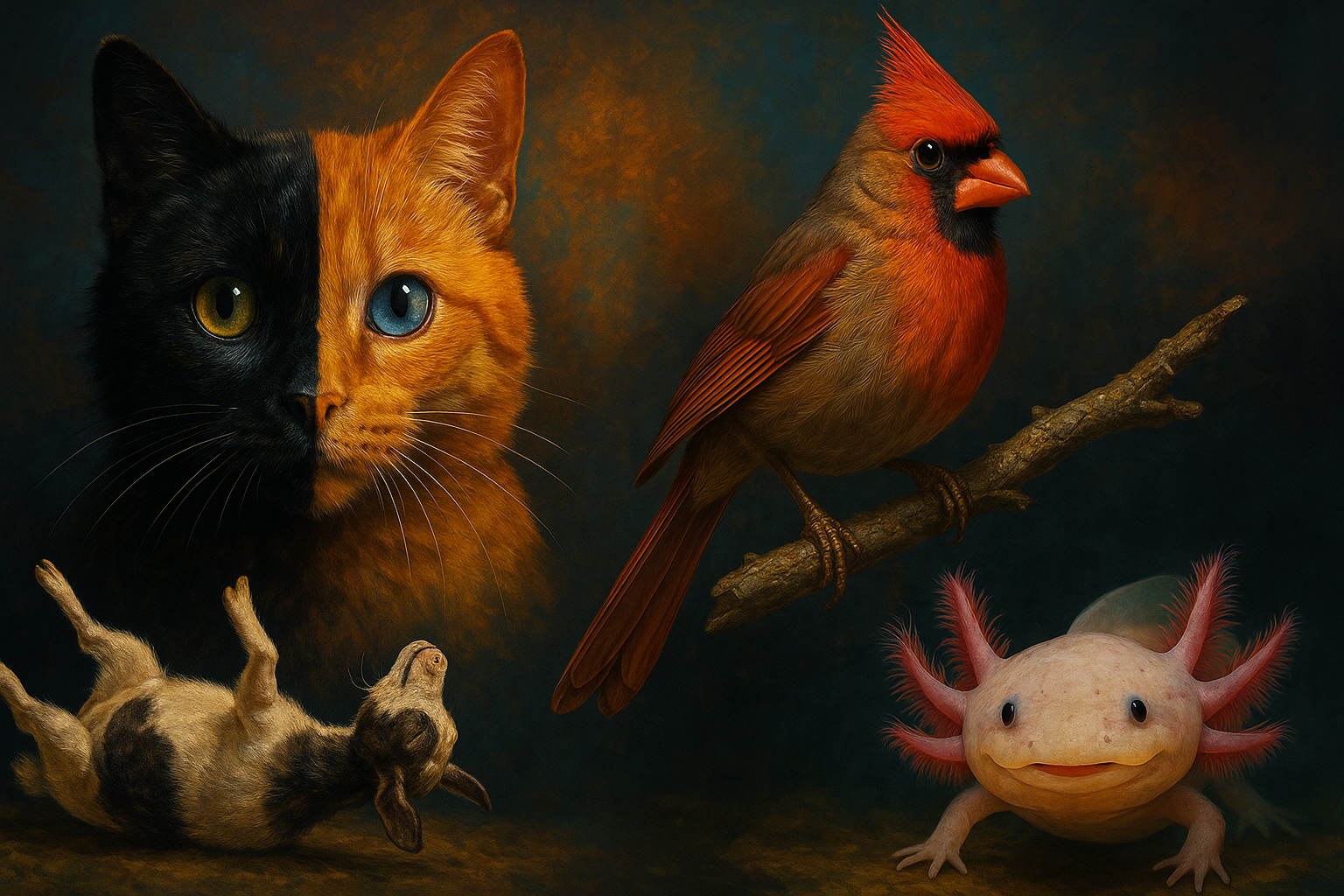
Nature is the ultimate artist, but sometimes, it feels more like a mad scientist. In the grand, silent library of life, every creature is a book written in a genetic code of just four letters. But this library isn’t static; it’s a place of constant revision, typos, and accidental edits. Through the random shuffle of genetics, these “edits”—mutations—occur. While many are neutral, vanishing like a whisper, and many are harmful, ending a story before it begins, some… some result in the most bizarre, astounding, and utterly strange creatures ever documented.
Personally, I find these “errors” in the genetic code to be the most fascinating subjects in all of biology. Why? Because they aren’t just mistakes; they are questions. They ask, “What if?” What if a snake had two brains? What if a cat was its own twin? What if an animal never had to grow up? These mutations defy our expectations, shatter our neat categories, and show just how incredibly flexible and creative life can be. They are the raw, unfiltered engine of evolution itself. So, let’s dive deep into 10 of the strangest, most mind-bending animal mutations ever recorded. Prepare to be amazed, and perhaps even to question what you thought was “normal.”
- 1. Polycephaly: The Two-Headed Wonders
- 2. Gynandromorphism: Split Down the Middle
- 3. Chimerism: The Mystery of Venus the Two-Faced Cat
- 4. Myotonia Congenita: The Famous “Fainting” Goats
- 5. Polydactyly: The Hemingway Cats with “Mittens”
- 6. The Color Spectrum: Albinism & Melanism
- 7. The Axolotl: Masters of Regeneration
- 8. The Texas Horned Lizard: A Bloody-Eyed Defense
- 9. The Star-Nosed Mole: A Super-Sensory Snout
- 10. Bioluminescence: Nature’s Eerie Glow
- Conclusion: Mutations as Nature’s Wild Experiments
1. Polycephaly: The Two-Headed Wonders

Perhaps the most classic “mutation” in mythology and reality is polycephaly, or having more than one head. This striking phenomenon occurs during embryonic development when an embryo that has begun to split into identical twins stops the process prematurely. The result is a single body with two (or sometimes more) heads. We’ve seen this documented in snakes, turtles, lizards, cattle, and even sharks.
It’s truly astounding to see footage of two-headed animals. The biological logistics are staggering. Often, the two heads have distinct personalities and brains. One might be more aggressive, the other more passive. One might be dominant in choosing which direction to move. They may even compete for food, attempting to steal it from the other’s mouth, despite the fact that both meals end up in the same shared stomach. I once read about a two-headed snake named “We” at the St. Louis Zoo, who lived for many years. Keepers had to feed both heads separately to keep them from fighting, even though it was one animal.
This raises such fascinating philosophical questions, doesn’t it? Is it one individual or two? When two brains inhabit one body, what is the nature of their consciousness? While their survival rate in the wild is tragically low—imagine trying to escape a predator when your two brains can’t agree on which way to run—their existence is a stark, living visual of a biological “what if?” They are the stuff of legends, like the Hydra, made real by a simple, random hiccup in cell division.
2. Gynandromorphism: Split Down the Middle

Imagine an animal that is biologically male on one side of its body and female on the other. This isn’t science fiction, or a creature stitched together in a lab; it’s a real biological phenomenon called bilateral gynandromorphism. It’s most famously and visibly seen in birds, like the Northern Cardinal. The difference is shocking. One side will be the brilliant, fiery red of the male, and the other the muted, earthy brown of the female. The dividing line is often razor-sharp, right down the center of the breast and back.
This phenomenon is thought to happen because of an error during the very first cell division of an embryo. In birds, sex is determined by ZW chromosomes (unlike our XY system). Males are ZZ, and females are ZW. A gynandromorph likely occurs when the female’s egg cell, for some reason, develops with *two* nuclei—one Z and one W. If this “double egg” is fertilized by two Z-carrying sperm, the resulting embryo starts developing with both ZZ (male) and ZW (female) cells. As these cells divide, one side of the body develops from the male cell line, and the other from the female line. It’s also seen in insects, like butterflies, where one wing will have the male coloration and the other, the female. It’s a stunning, beautiful, and profound example of genetics made visible, a living mosaic of two possibilities in one body.
3. Chimerism: The Mystery of Venus the Two-Faced Cat

You may have seen her online, and she is unforgettable: Venus, the “two-faced” cat. One side of her face is solid black with a piercing green eye; the other side is a classic orange tabby with a brilliant blue eye. The split is almost perfectly vertical. For years, she was hailed as a perfect example of a chimera.
What is a chimera? It’s an organism formed when two different fertilized eggs (embryos) fuse together in the womb at a very early stage of development. Essentially, two non-identical twins merge to become a single individual. This one animal would then carry two completely distinct sets of DNA. It’s a mind-bending concept—being your own fraternal twin. This *does* happen in humans, sometimes discovered by accident through genetic testing.
However, the truth about Venus might be even stranger! Geneticists who have pondered her case suggest she might not be a chimera at all, but rather an extreme and incredibly lucky case of “mosaicism.” Mosaicism is when a single embryo develops with different cell lines, but it all comes from *one* fertilized egg. The perfect split-face could be caused by X-chromosome inactivation—a normal process in female mammals where one of the two X chromosomes in every cell is randomly “switched off.” Venus might just be a calico cat where the “random” switching just happened to occur in a perfect, tidy line down her face. And the blue eye? That’s another puzzle, usually linked to white fur (which Venus lacks on that side). Personally, I love that she remains a beautiful mystery. She reminds us that even after all our scientific advances, nature can still present us with a puzzle that defies a simple answer.
4. Myotonia Congenita: The Famous “Fainting” Goats

Ah, the “fainting” goats of internet fame! We’ve all seen the videos: someone startles a herd of goats, and suddenly, their muscles seize up, causing them to fall over stiff-legged, looking like toppled statues. It’s a dramatic, and admittedly comical, sight. But here’s the fascinating part: they aren’t fainting at all. They don’t lose consciousness for a second. They are completely awake, just temporarily immobilized.
This bizarre behavior is caused by a hereditary genetic disorder called Myotonia Congenita. It’s a mutation in a specific gene, CLCN1, which is responsible for creating a chloride ion channel in the cell membranes of skeletal muscles. In a normal goat (or human, as we have this condition too), when you decide to move, your brain sends a signal, the muscle contracts, and these chloride channels help the muscle “reset” and relax almost instantly. In myotonic goats, this channel is defective. The “flight” signal tells the muscles to contract, but the mutation prevents them from relaxing immediately. The muscle stays rigid for about 10 to 20 seconds. It’s like trying to run, but your legs are locked in place.
Interestingly, this breed was preserved by humans precisely *because* of this mutation. It made them easier to manage—they couldn’t jump over low fences. It’s a strange case of a “disorder” becoming a desirable trait. While sources say it’s typically painless for the goat, I can’t help but feel a twinge of empathy. Imagine feeling that sudden, startling paralysis every time you’re surprised! It’s a powerful example of how genetics can profoundly alter an animal’s entire experience of the world.
5. Polydactyly: The Hemingway Cats with “Mittens”

If you ever have the chance to visit the Ernest Hemingway Home and Museum in Key West, Florida, you’ll be greeted by a furry, multi-toed welcoming committee. The grounds are home to nearly 60 cats, many of whom are descendants of Hemingway’s famous six-toed cat, a white feline named Snow White. This mutation is called polydactyly (from the Greek for “many fingers”), and it results in cats having extra toes, making their paws look like adorable, oversized “mittens.”
This is a simple autosomal dominant gene mutation, meaning only one parent needs to carry the gene to pass it on to about half of its offspring. While a normal cat has 18 toes (five on each front paw, four on each back), these “Hemingway cats” can have six, seven, or even more toes per paw. The extra digit often forms a “thumb,” giving the cat a distinct advantage in grasping and climbing.
This mutation wasn’t just a curiosity; it was a practical trait. Sailors, in particular, prized polydactyl cats. They were believed to be superior mousers and, thanks to their larger, wider paws, were thought to have better balance on ships navigating rough seas. Snow White was, in fact, a gift to Hemingway from a ship’s captain. It’s a wonderful example of a mutation that isn’t harmful at all, but instead provides a unique (and very cute) variation that found its own special, and quite famous, niche in human history.
6. The Color Spectrum: Albinism & Melanism

These are mutations we are all familiar with, but their ubiquity doesn’t make them any less striking. They represent two ends of the pigment spectrum, both caused by simple genetic tweaks.
- Albinism: This is a mutation that causes a complete lack of melanin, the pigment responsible for color in skin, fur, scales, and eyes. This results in the characteristic white fur or scales and, most tellingly, pink or red eyes. Why red eyes? Because there’s no pigment in the iris to block the color of the blood vessels at the back of the eye. It’s a mutation that is often beautiful but devastating in the wild, as it removes all camouflage and makes the animal highly sensitive to sunlight.
- Melanism: This is the genetic flip side—an excess of black pigment (eumelanin). The most famous example, of course, is the “black panther.” This isn’t a separate species. A black panther is simply a melanistic jaguar (in the Americas) or a melanistic leopard (in Asia and Africa). It’s a dominant mutation in jaguars but recessive in leopards. And here’s my favorite part: if you look closely at a black panther in the right light, you can still see its spots! The pattern is all there, just masked by the overwhelming black pigment. It’s like a secret hidden in plain sight.
Between these two extremes, you also have leucism (a partial loss of pigment that doesn’t affect the eyes) and erythrism (a reddish pigment mutation). Together, they show how a few simple genetic pathways control the entire visual appearance of the animal kingdom.
7. The Axolotl: Masters of Regeneration

Now, this one… this one just blows my mind every time I think about it. The Axolotl, a type of salamander native *only* to a few lakes near Mexico City, has a mutation that is essentially a biological superpower. It’s the real-life Wolverine, but better.
First, the axolotl exhibits “neoteny,” which means it’s a “Peter Pan” animal. Thanks to a genetic mutation, it never fully goes through metamorphosis. It remains in its larval, aquatic form (with those feathery external gills) its entire life, even reaching sexual maturity in this “juvenile” state. But that’s just the start. Its true mutation is its mastery of regeneration. And I don’t just mean growing back a tail, like some lizards. An axolotl can regenerate lost limbs, its spinal cord, its tail, parts of its heart, and even portions of its brain—all without any scarring. It perfectly rebuilds the bone, muscle, nerves, and skin.
How? When wounded, its cells form a structure called a “blastema,” a mass of undifferentiated cells that somehow “remember” what they are supposed to become, and they regrow the entire complex structure from scratch. This incredible ability, linked to its unique genetic makeup, is being studied intensively by scientists around the world. The dream, of course, is to one day unlock the secrets of the axolotl’s genome to improve human medicine, potentially allowing us to repair spinal cord injuries or damaged heart tissue. It’s a mutation that holds almost mythical promise.
8. The Texas Horned Lizard: A Bloody-Eyed Defense
If you saw this defense mechanism in a low-budget horror movie, you’d roll your eyes and call it bad special effects. But for the Texas Horned Lizard (and several related species), it’s a very real and very gruesome reality. When threatened by a predator, particularly a canine like a coyote or fox, this lizard has one of the strangest and most shocking mutations in its arsenal.
It can intentionally restrict the blood flow from its head, building up immense pressure in the tiny vessels around its eyes. Then… *pop!* It deliberately ruptures the tiny capillaries in its eyelids and squirts a targeted, high-pressure stream of its own blood at its attacker. It can aim this stream with surprising accuracy, often hitting the predator directly in the mouth, at a distance of up to five feet.
But why? It turns out this blood isn’t just for show. It contains a specific chemical compound, acquired from its diet of harvester ants, that has a foul, noxious taste to canines. The predator is so shocked and disgusted by the bloody, foul-tasting surprise that it will often drop the lizard and flee, allowing it to make its escape. What an incredibly specific, bizarre, and frankly metal evolutionary trick! It’s a testament to the fact that in the arms race of survival, *any* mutation, no matter how strange, can become a winning strategy.
9. The Star-Nosed Mole: A Super-Sensory Snout
This creature looks like it was designed by a committee of science fiction authors. The Star-Nosed Mole, which lives in the dark, wet, marshy ground of North America, has a “nose” that has mutated into something truly alien: 22 fleshy, pink, tentacle-like appendages that form a “star” at the end of its snout. This bizarre star is not for smelling; it’s a sensory organ of unbelievable sensitivity and speed.
The “star” is covered in over 25,000 tiny, domed sensory receptors (called Eimer’s organs). This makes it one of the most sensitive touch organs in the entire animal kingdom. The mole, living in total darkness, uses this star to “see” its world. It constantly taps the ground, and its brain processes the information so fast that it can detect and identify an edible item (like a tiny worm) in as little as 120 milliseconds. That’s faster than the human eye can blink.
In fact, its brain’s sensory map (the “homunculus”) is dominated by this star, much as a human’s is dominated by our hands and face. It’s one of the fastest foragers in the animal kingdom, all thanks to this wonderfully strange mutation that effectively turned its nose into a set of high-speed, 3D-scanning fingertips. It’s a perfect example of mutation driving extreme specialization.
10. Bioluminescence: Nature’s Eerie Glow
While bioluminescence (the ability to produce light) is a common trait in the pitch-black of the deep sea, one specific mutation in a humble jellyfish has given humanity one of its most powerful scientific tools. I’m talking about the Green Fluorescent Protein (GFP) mutation, first isolated from the crystal jellyfish, *Aequorea victoria*.
This jellyfish produces a protein that, when hit by blue light, absorbs it and re-emits it as a bright, eerie green glow. In the 1990s, scientists (notably Osamu Shimomura, Martin Chalfie, and Roger Tsien, who won a Nobel Prize for this) figured out how to isolate the gene for GFP. This is where the magic happened. They learned to take this glowing gene and, using genetic engineering, attach it to *other* genes in *other* animals.
What does this mean? It means scientists can now “tag” almost anything and watch it in real-time. Want to see how Alzheimer’s plaques spread in a mouse brain? Tag them with GFP. Want to watch cancer cells metastasize? Tag them with GFP. You can watch viruses infect cells, see neurons fire, or track the development of an embryo, all by watching for that tell-tale green glow. This single, simple mutation from a jellyfish has truly revolutionized medical research, turning the invisible processes of life into a visible, luminous spectacle.
Conclusion: Mutations as Nature’s Wild Experiments
From two-headed snakes to blood-squirting lizards, from cats that are their own twins to animals that hold the secret to regeneration, these mutations show that the rulebook of life is constantly being rewritten. They are not “mistakes” so much as they are opportunities—nature’s way of testing new designs, new abilities, and new ways to survive. They are the scribbled notes in the margins of the genetic code, the rough drafts, the wild ideas.
It’s a beautiful, chaotic, and endlessly surprising process. Most mutations fail. But some, through sheer, blind luck, create something new, something specialized, something… wondrous. The next time you see any animal, no matter how “normal” or “strange,” remember: you’re looking at a living, breathing story of genetic chance, a masterpiece of adaptation billions of years in the making, built one tiny, random mutation at a time.
As always, the natural world is full of wonders. For more information on these specific genetic conditions, I highly recommend consulting resources from zoological societies, genetic research institutions, and university biology departments. Keep exploring!


